The mining sector faces many unique challenges in interpreting and applying International Financial Reporting Standards (IFRS), according to Real Time – IFRS in the mining sector, a new report from PricewaterhouseCoopers. Brian Taylor, UK Mining Leader, PricewaterhouseCoopers said, “These challenges reflect the specific characteristics of the industry and also the absence of detailed industry guidance.”
In explaining the challenges faced by the industry, the report points out that many IFRS requirements do not reflect important characteristics of the mining industry, including:
-
The need for large up-front investment, with low success rates on exploration spending and long lead-times on new projects
-
The existence of significant back-end costs, when mines are eventually closed, in decommissioning processing facilities, rehabilitating the sites and managing obligations to the workforce and local communities
-
The existence of activities which result in saleable production but also contribute towards the development of the mine, and hence deliver longer term benefits as well.
The interaction with US Generally Accepted Accounting Principles (GAAP), and the move towards convergence, brings further challenges in interpreting IFRS – at a time when the Securities and Exchange Commission is taking an active interest in how US GAAP should be applied to the mining industry.
Areas of particular difficulty for the sector include the accounting for reserves and resources; deferred stripping (which has recently been outlawed under US GAAP); commissioning and decommissioning; long term stockpiles; impairment; and functional currency. International Accounting Standard 39 (IAS 39), dealing with the recognition and measurement of financial instruments, has also posed challenges – as it has for many industries. Mining companies which assumed initially that their activities would fall outside IAS 39 have generally found that this is not the case, for example because of the rules on so-called “embedded derivatives.”
A lot of companies have now completed their IFRS conversion projects, and have produced their first annual reports under IFRS. ‘Real Time – IFRS in the mining sector provides insight into how companies have dealt with some of the key IFRS issues facing the industry, through examples of the accounting policies published in mining companies’ IFRS financial statements.
According to Taylor, “Companies have adopted a consistent approach in many areas, and there is no doubt that the introduction of IFRS has advanced the transparency and comparability of financial statements. However, there are also some areas in which practice appears to vary across the industry. In such cases, the disclosure of a company’s accounting policies – and also the consistent application of those policies – is particularly important.”









